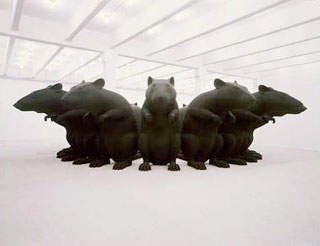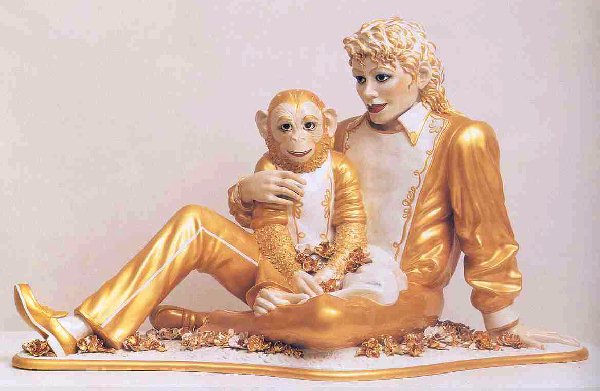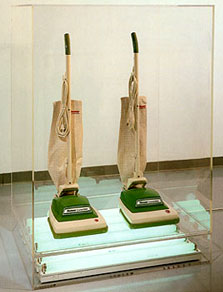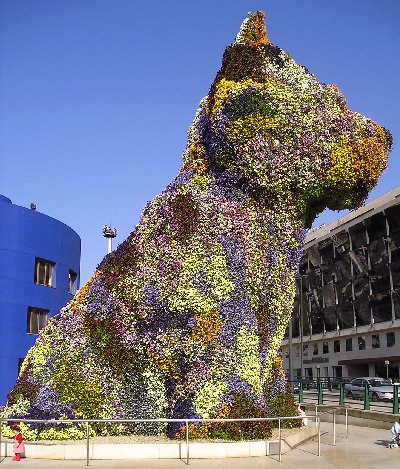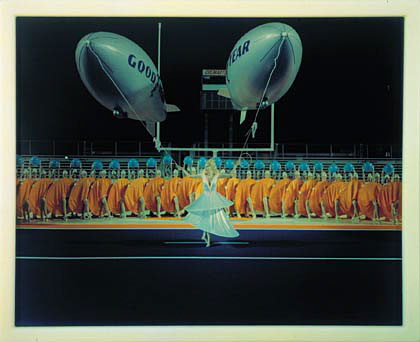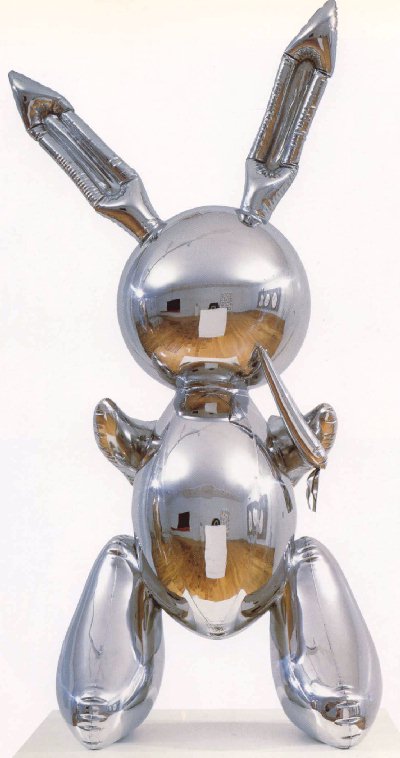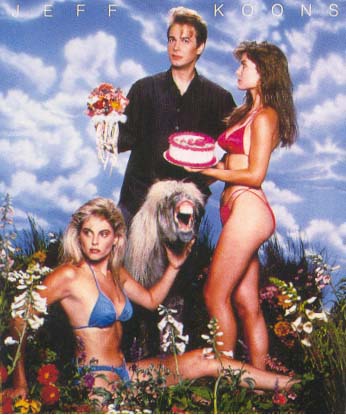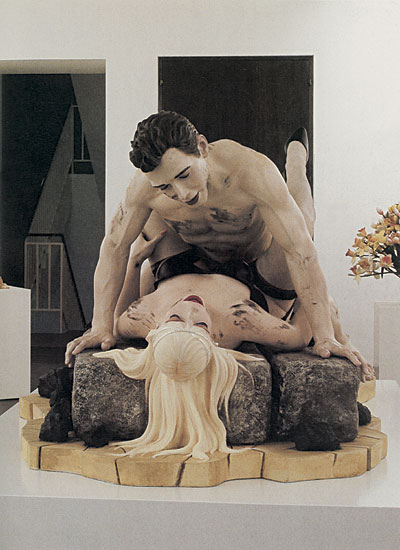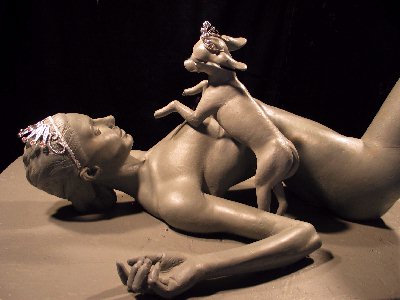| Neo-Pop Art
The Art History Archive - Pop Art
The Rebirth of Pop ArtIn the 1980s there was a renewed interest in the Pop Art of Andy Warhol and contemporaries. Warhol died in 1987, but he had long before inspired a while generation of new artists. It should be noted that Neo-Pop Art is not really a new art movement, but rather an evolution of the old Pop Art movement. Neo-Pop Art consists of a revised form of Pop Art adapted from its forefathers, a rebirth of recognizable objects and celebrities from popular culture with icons and symbols of the present times. Excellent examples are Katharina Fritsch's 1993 sculpture "Rat-King" and Jeff Koon's 1988 sculpture: "Michael Jackson and Bubbles".
The Evolution of Pop ArtThis type of Pop Art often relies heavily on broadening the idea of readymades and using pre-existing items to create a final product, first developed by Dadaist Marcel Duchamp, and also borrowing heavily from cultural icons (such as Michael Jackson, Madonna, Britney Spears, Paris Hilton, etc). Neo-Pop Art relies heavily on the mass media both for influence/inspiration but also for promoting their work (Daniel Edwards for example gets a lot media attention for his controversial nude sculptures of celebrities). Neo-Pop Art tends to criticize and evaluate Western Culture, values, relationships, and interactions, frequently poking fun at celebrities and openly embraces ideas that are provocative and controversial. What we call Neo-Pop Art is certainly not a movement but a convenient way of classifying this new list of diverse artists. The work of these artists also draws inspiration from Minimalism, Conceptual Art, Photorealism, Installation/Performance Art and more. The original Pop Art movement was boundary breaking and avant garde whereas Neo-Pop Art is not a new style, but a dramatic and controversial evolution of the previous generation. It could also be called "Shock Pop Art".
Neo-Pop AnimalsDuring the early years of Neo-Pop Art a common theme was the use of animals in their art, especially in the work of Jeff Koons, Katharina Fritsch, Keith Haring and Damien Hirst. Their obsession with portraying or even using members of the animal kingdom into their work comes out in Keith Haring's cartoon dogs, Jeff Koons' inflatable plastic rabbits and carved dogs, Katharina Fritsch's giant menacing rats, or Damien Hirst's formaldehyde dissections. Another characteristic of this second generation is the psychological evaluations often embedded within the work. Charles Ray and Jeff Koons succeed at disguising their intentions, Damien Hirst and Katharina Fritsch proclaim their intentions. Hirst uses disturbing subject matter and pessimistic titles, while Fritsch uses anxiety and fear provoking sculptures. Old Pop Art was not very thought provoking and embraced nihilism, capitalism and consumer culture and Neo-Pop Art has evolved with an almost sinister tone that strongly criticizes our fears and our obsessions.
Neo-Pop Artists
Examples of Neo-Pop ArtJeff Koons - New Hoover Convertibles - 1984 Jeff Koons - Michael Jackson and Bubbles - 1988 Yasumasa Morimura - Portrait Twin - 1988 Jeff Koons - Dirty: Jeff on Top - 1991 Jeff Koons - Blow Job: Ice - 1991 Katharina Fritsch - Mann und Maus / Man and Mouse - 1991-92 Matthew Barney - Cremaster 4 - 1994 Matthew Barney - Cremaster 1: Goodyear Chorus - 1995 Katharina Fritsch - Rat-King - 1993 Katharina Fritsch - Pistole / Pistol - 2006 Daniel Edwards - Monument to Pro-Life: The Birth of Sean Preston (Britney Spears) - 2006 Daniel Edwards - Bust of Hillary Rodham Clinton - 2006 Daniel Edwards - Paris Hilton Autopsy - 2007 Daniel Edwards - Prince Harry Dead in Iraq War Memorial - 2007 |
|
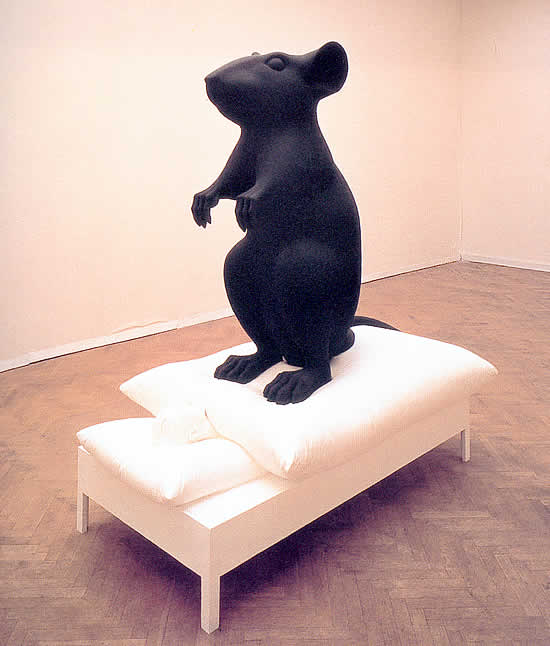
Katharina FritschGaining not only American, but also European attention, Katharina Fritsch entered the realm of the art world and quickly established herself as a distinguished woman sculptor. Being one of the few prominent females in an arena that mainly showcased the talents of men; she boldly led her gender towards recognition in the area of recent Neo-Pop Art. Katharina was born in 1956 in Germany and began her studies there at the Kunstakademie. Her work resembles that of Jeff Koons, and Andy Warhol in the fact that she often takes objects from popular culture and though replication and exploitation alters the contextual content of these items. This practice of taking objects from the social environment and manipulating their form can be seen as a result of Koons' "kitchy, souvenir art" influence. Through color and content, Fritsch is able to transform these duplicated images into viable pieces of art. Her work though, should not be confused with his practice of assisted ready-mades. While her sculptures are modeled after items of popular culture, each replica has been physically handcrafted by the artist herself. An example is an oversized, fluorescent yellow replica of the Madonna, one of her most famous sculptures. Its arena is a small town's square, in a space wedged between a public warehouse and a church. Through its placement the sculpture acts as a juxtaposing monument. Its form illustrates the harsh contradictions between the morals of the church and its color seemingly representing the rebellious actions of state society. Ironically though, through placement, it also serves as a link that binds the two contradicting worlds together. From Warhol she borrows the principle of repetition. She often creates a large number of one particular sculpture, all the same in form and size. Through monotonous replication she is able to change the connotation that the object was originally meant to express. Another characteristic fluent in Fritsch's work is her menacing portrayal of animals. In her famous sculpture, "The Rat King", Katharina sculpted a ring of life-sized rats. Each rat is eight feet tall, and perched on its hind legs. Facing outwards they cautiously raise their tiny front paws in suspicious guard. Inside their circle is a knotted configuration, made by the intertwining of each rat's tail. Legend has it that during particular seasons, groups of rats would congregate and through the connection of their tails, take on supernatural powers. Man's caution and fear of these creatures stems from their role as a vehicle in the spread of the bubonic plague, an epidemic which killed thousands of Europeans during the fourteenth century. The size of Fritsch's sculpture works to her advantage by providing the viewer with an unexpected, abrupt startle, again reinstating the same fear and continued apprehension of these creatures. Building further on these same principles of uneasiness and suspicion, Katharina created "Man and Mouse". The sculpture is oversized and uncomfortably realistic, consisting of a man lying in bed on his back. Upon his stomach resides an equally large rat resting on his haunches, boldly staring the man directly in the face. The viewer cringes with uneasiness as once again they're confronted with frightful foreboding in regards to the rat's intentions, and therefore welfare of the man. Not limiting herself to only varmints, Katharina evokes disturbance directed towards the dog, a creature usually considered man's best friend. This piece consists of life-sized black poodles encircling a white, human newborn. One's first reaction is initial alarm for the safety of the child. Being left uniformed about the context of the events in the scene, the viewer shudders and approaches the piece with caution, almost in an attempt to avoid startling the figurine dogs and provoking a violent reaction. This nervous anxiety remains until the viewer once again returns to the realm of the natural world, comforted by the reminder that these hazardous perils exist only in fictional art and not in reality. Or do they? Katharina Fritsch has earned her role in today's art world as a leading female sculptor. Through her talent of viewing situations with a unique, supernatural twist, she has brought to the forefront a new range of emotions for her audience to experience. Her work is shown in the United States at one of New York's most advanced art galleries, Matthew Marks, located in Chelsea. Two recent installations shown there in 2000, "Money Heart" and "Witches House with Mushroom and Four Balls" continue her interest in basing her work on myths and fairy tales. Jeff KoonsWhen discussing art and the controversy of its context, one cannot fail to recognize Neo-Pop artist Jeff Koons. Born in 1955, in York, Pennsylvania, Jeff inherited his artistic background from his father, a self-employed interior decorator. When merely five years of age, he participated in his first structured art lesson, igniting the passion that would influence the rest of his life. Koons began his artistic career studying at the Maryland Institute of Art, only to transfer three years later to the Art Institute of Chicago. Interestingly, after several years of artistic education, Jeff felt the urge to make a career shift, and opted to experiment with his marketing skills in the business setting. He, like so many before him, set out to conquer Wall Street, eventually settling on the position of a commodity broker. But like any other artist brimming with creativity and trapped in a confining setting, Koons broke free from his binding ties and returned to the world of art in New York City. Modeling himself after the style of Andy Warhol's Pop Art, and Marcel Duchamp's ready-mades, Koons delighted in the controversy and artistic debate that accompanied his works. Early in his career his elation with the defiance of the norm became evident. He, like many of his fellow Neo-Pop artists, drew on the influence and unrestrained ideals of the big city clubs and streets. Jeff added a facet of interest to his work by incorporating the theory of kitch and camp into his style. Combing properties of kitch, images not usually considered artistic, and camp, items so absurdly irrelevant that they create a new sense of interest, Jeff quickly gained attention and criticism. Using what was often viewed as "tacky" plastic souvenir objects, or bright pieces of inflated vinyl as a medium, Koons developed a new provocative style of ready-made sculpture. Later, to ensure permanency, and durability, he began to cover the objects in shell of brass or metal. Stirring the opinions of the critics even further, Koons launched another debatable campaign with his incorporation of common household appliances into his work, and therefore the realm of art. For the composition of these assisted ready-mades, he combined his interest in physics and technology, with brimming creativity in regards to context and aesthetics. Several of his most interesting pieces include items that one might find in their own utility closet or garage. In his creation of the new work, Jeff utilized the lowly status of everyday Hoover vacuum cleaners by placing them in a showcase with fluorescent lighting, elevating them to museum quality works of art. Possibly the most famous piece from his collection of ready-mades is "Equilibrium", which consists of nothing more than a collection of basketballs floating at varying levels in an aquarium, accompanied by oil paintings of Nike advertisements. While these seemingly simple pieces may seem to be an insult to the art world they were in fact, carefully constructed with a great deal of consideration as well as intellect. For the creation of "Equilibrium", Koons went so far as to consult with physicist and Nobel Prize Laureate, Dr. Richard Feynman. Perhaps though, the most interesting aspect of Koon's art, was the realm that was also viewed by critics as the most intimate. Always being one to inspire debate, Jeff incorporated this controversy into his lifestyle as well. Marrying (and eventually divorcing) Italian porn star, Cicciolina, he publicized through film and sculpture the most private aspects of their sexual relationship. It seems that by his personal consent to publish these works, he seeks to avoid creating sexual arousal, and instead liberates the viewer from self-consciousness and observes his art without guilt. Dabbling in the realm of topiary sculpture, Koons has made startling innovations in the horticultural area of art. His earthly topiary "Puppy" has its own irrigation system, and holds hundreds of thousands of flowers. Composed entirely of organic material, Koons seems to have literally breathed life into art. In one of Jeff's more current shows, a series entitled "Celebration", he expresses a childlike sense of nostalgia and excitement expressed through color and subject matter. He becomes enveloped in vivid paintings and sculptures of children's games, toys, and animals. One critic seemed to sense that the animation and exhilaration was actually only a diversion masking Koon's underlying emotions of longing and sorrow for his young son Ludwig, who lives apart from Koons in England. To keep his name out front and his work well known, Koons has once again entered the marketing realm of society. He recently made a business agreement with an online art retailer, Eyestorm. For a mere five hundred dollars, one can purchase, online, a print of Jeff's work. By keeping his pieces in a contemporary setting, Koons has creatively ensured that his fame and credibility outlast everyone's expectations. Jeff Koons is by no means a static artist, proven by his undying desire to incorporate all aspects of life into art. His ready-mades, though often discredited as true art, do however prove themselves an art form by the controversy they inspire. Koons, like his predecessor Marcel Duchamp, seems to delight in the friction and irritation that his pieces provoke, as he continues to constantly challenge the system. His diversity in relation to medium and aesthetics keep his work dynamic as he continues to keep his critics aggravated and annoyed. Daniel EdwardsDaniel Edwards is an American sculptor/Neo-Pop artist born in La Porte, Indiana in 1965. His pieces address celebrity and popular culture in ways that have often stirred controversy. The release of the pieces is generally accompanied by press releases. His works include a sculpture of the disembodied head of Ted Williams, a life-sized statue of Britney Spears giving birth while nude on her hands and knees on a bearskin rug, a bust of Senator Hillary Clinton, and a 25 foot bust of Fidel Castro. Edwards titled his piece about Britney Spears "Monument to Pro-Life: The Birth of Sean Preston," explaining that it symbolized Spears' decision to put childbirth ahead of her career. Britney Spears actually had a caesarean section. In an Associated Press interview, Edwards asserted that he incorporates celebrity stories because: "Youíre bombarded with these stories. And thereís a thread that winds back to the art. Thatís not a bad thing. People are interested in sex, and it works for art as well." Edwards conceded, however, that he "wouldn't march with either pro-life or pro-choice advocates".
| |
